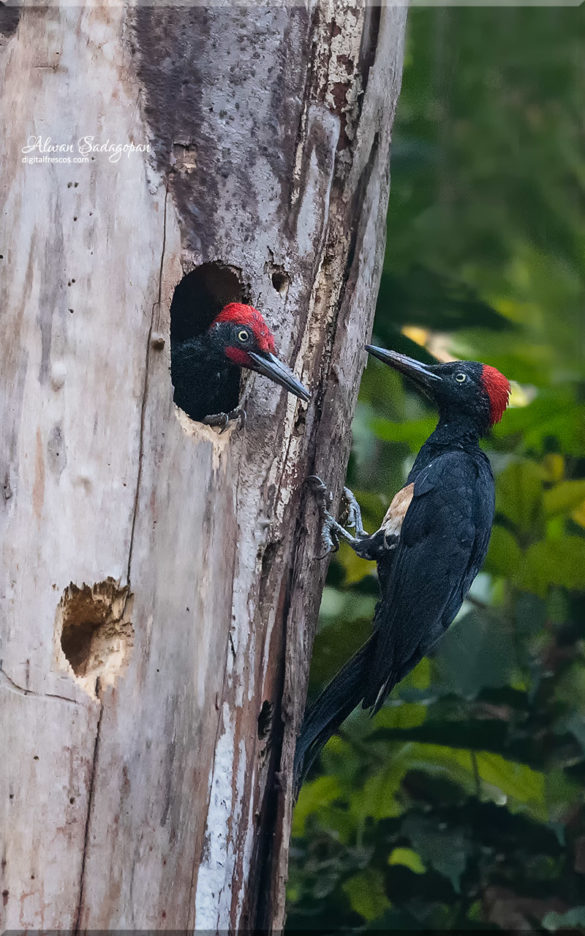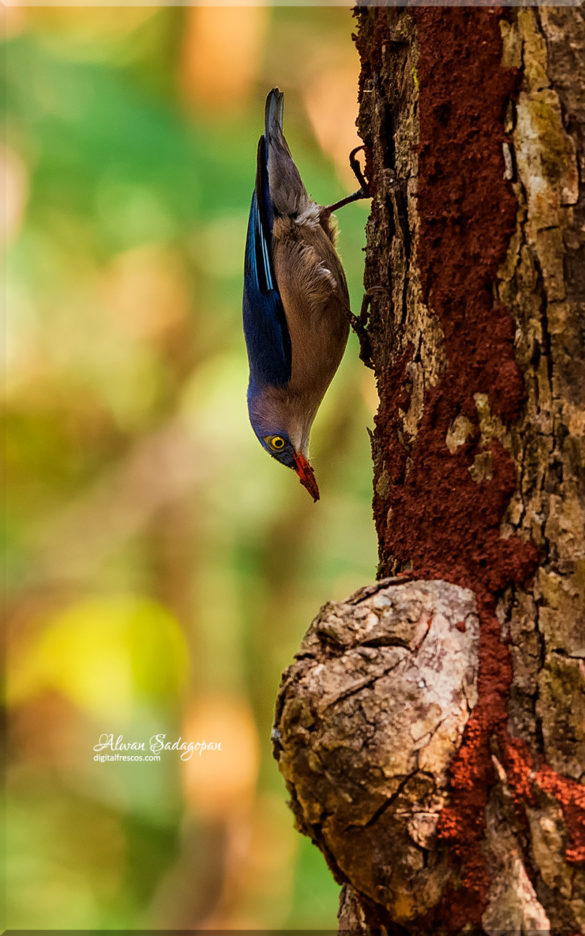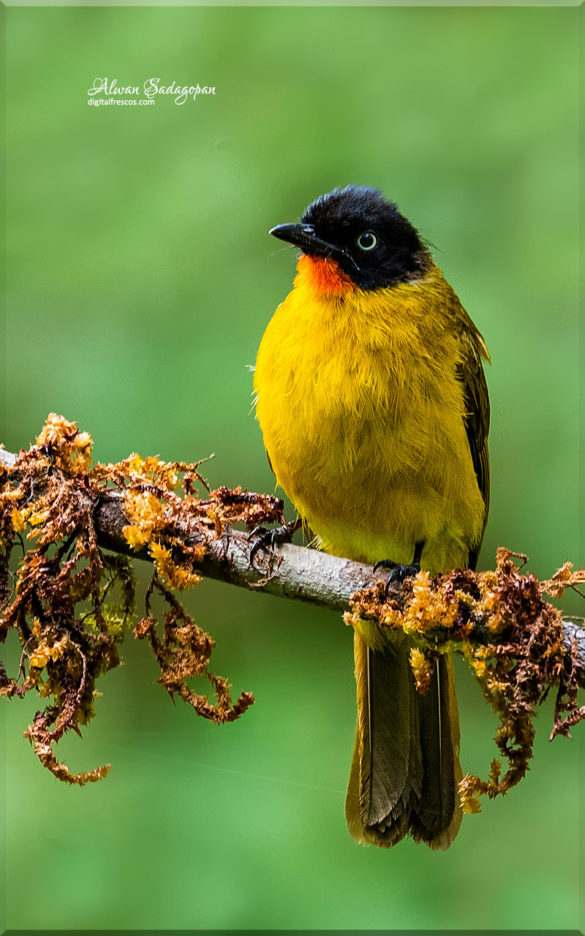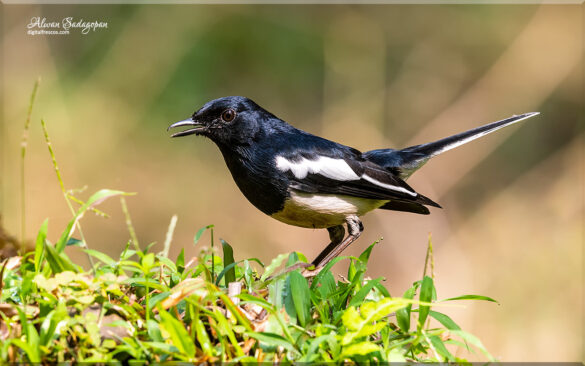
The white-rumped shama (Copsychus malabaricus) is a small passerine bird of the family Muscicapidae. Native to densely vegetated habitats in the Indian subcontinent and Southeast Asia. It was formerly classified as a member of the thrush family, Turdidae, causing it to be commonly known as the white-rumped shama thrush or simply shama thrush. They typically weigh between 28 and 34 g (1.0 and 1.2 oz) and are around 23–28 cm (9–11 in) in length. Males are glossy black with a chestnut belly and white feathers on the rump and outer tail. Females are more greyish-brown, and are typically shorter than males. Both sexes have a black bill and pink feet. Juveniles have a greyish-brown colouration, similar to that of the females, with a blotchy or spotted chest. They feed on insects in the wild but in captivity they may be fed on a diet of boiled, dried legumes with egg yolk and raw meat. It mainly feeds mainly on arthropods, including ants, caterpillars, moths, beetles, flies, grasshoppers, centipedes, spiders, also worms and berries. The voice of this species is rich and melodious which makes them popular as cage birds in South Asia with the tradition continuing in parts of Southeast […]

The white-bellied woodpecker or great black woodpecker (Dryocopus javensis) is found in evergreen forests of tropical Asia, including the Indian subcontinent and Southeast Asia. It has 14 subspecies, part of a complex including the Andaman woodpecker (Dryocopus hodgei) (earlier treated as a subspecies). Many island forms are endangered, some are extinct. Populations differ in the distribution and extent of white. They are among the largest of the Asiatic woodpeckers and nest in large dead trees, often beside rivers. Their drums and calls are louder than those of the smaller woodpeckers. This species is one of the largest living species of woodpecker. Adults range in size from 40 to 48 cm (16 to 19 in) and are second in size only to the great slaty woodpecker among Asian woodpecker species. The species is considered closely related to the more northern black woodpecker and the North American pileated woodpecker and is similar in size to these species. This large black woodpecker is usually seen singly or as a pair, which may sometimes be accompanied by a third bird. They have a dipping in which the loud single note, a laugh-like chiank call, is produced. They also produce loud drumming, especially in […]

The velvet-fronted nuthatch (Sitta frontalis) is a small passerine bird in the nuthatch family Sittidae found in southern Asia from Nepal, India, Sri Lanka and Bangladesh east to south China and Indonesia. Like other nuthatches, it feeds on insects in the bark of trees, foraging on the trunks and branches and their strongly clawed toes allow them to climb down tree trunks or move on the undersides of horizontal branches. They are found in forests with good tree cover and are often found along with other species in mixed-species foraging flocks. Adult males can be told apart by the black stripe that runs behind and above the eyes. They have a rapid chipping call note. The velvet-fronted nuthatch has the typical nuthatch shape, short tail and powerful bill and feet. It is 12.5 cm long. It is violet-blue above, with lavender cheeks, beige underparts, yellow eyes, and a whitish throat. The iris is distinctly pale and yellow. The bill is red, and there is a black patch on the forehead and lores which is well developed in adults and less so in younger birds. Young birds have a dark beak and dark tips to the undertail coverts. Adult males […]

The velvet-fronted nuthatch (Sitta frontalis) is a small passerine bird in the nuthatch family Sittidae found in southern Asia from Nepal, India, Sri Lanka and Bangladesh east to south China and Indonesia. Like other nuthatches, it feeds on insects in the bark of trees, foraging on the trunks and branches and their strongly clawed toes allow them to climb down tree trunks or move on the undersides of horizontal branches. They are found in forests with good tree cover and are often found along with other species in mixed-species foraging flocks. Adult males can be told apart by the black stripe that runs behind and above the eyes. They have a rapid chipping call note. The velvet-fronted nuthatch has the typical nuthatch shape, short tail and powerful bill and feet. It is 12.5 cm long. It is violet-blue above, with lavender cheeks, beige underparts, yellow eyes, and a whitish throat. The iris is distinctly pale and yellow. The bill is red, and there is a black patch on the forehead and lores which is well developed in adults and less so in younger birds. Young birds have a dark beak and dark tips to the undertail coverts. Adult males can […]

Tickell’s blue flycatcher (Cyornis tickelliae) is a small passerine bird in the flycatcher family. The name commemorates the British ornithologist Samuel Tickell. This is an insectivorous species which breeds in tropical Asia, from the Indian Subcontinent eastwards to Bangladesh and western Myanmar. The Indochinese blue flycatcher was formerly considered conspecific. They are blue on the upperparts and the throat and breast are rufous. They are found in dense scrub to forest habitats. Tickell’s blue flycatcher is about 11–12 cm long. It sits upright and forages mainly in the overgrowth. The male’s upper parts are bright blue, its throat and breast are red, and the rest of the underparts are white. The female is duller blue with a brighter blue brow, shoulder, rump, and tail. It hybridizes with the pale-chinned blue flycatcher (Cyornis poliogenys) in the Eastern Ghats of India and these hybrids have sometimes been called the subspecies vernayi. The juvenile is streaked and has a spotted mantle, scaly brown upperparts, head and breast, with just the wings and tail being blue. They have sometimes been known to feed even after dusk. Apart from flying insects they have been noted to occasionally glean crawling insects. The species shows regional […]

The southern hill myna (Gracula indica) is a member of the starling family. It is a resident of southwest India and Sri Lanka. This was formerly considered conspecific with Common hill myna G. religiosa, but maintained as a separate species differing in its long, narrow serrated wattle on hindcrown; much shorter wings than closest form of G. religiosa; proportionately finer bill; “striking vocal differences”. 23–25 cm; 126 g. Medium-sized black myna with bare patch below eye clearly separated from bare postorbital skin, which extends back to nape, where there is a yellow-orange wattle. The habitat of the southern hill myna is Wooded country, including evergreen forest and well-wooded cultivated areas. This myna is almost entirely arboreal, moving in large, noisy groups of half a dozen or so, in tree-tops at the edge of the forest. It hops sideways along the branch, unlike the characteristic jaunty walk of other mynas. Like most starlings, the hill myna is fairly omnivorous, eating fruit, nectar and insects. The main diet includes fruit and nectar: fruit of figs (Ficus) and berries of sapu tree. Not globally threatened classified as Least Concern by IUCN. Often treated as a race of G. religiosa. Probably not globally […]

The flame-throated bulbul (Pycnonotus gularis) is a member of the bulbul family of passerine birds. It is found only in the forests of the Western Ghats in southern India. Formerly included as a subspecies of Pycnonotus flaviventris it has since been elevated to the status of a full species. They are olive backed with yellow undersides, a triangular orange-red throat and a white iris that stands out against the contrasting black head. They are usually seen foraging in groups in the forest canopy for berries and small insects. They have a call often with two or three tinkling notes that can sound similar to those produced by the red-whiskered bulbul. The species has been referred to by names in the past such as ruby-throated bulbul and black-headed bulbul. The flame-throated bulbul keeps in small flocks and feeds on berries, including those of Lantana sp. It inhabits evergreen forests often along streams and valleys. The flame-throated bulbul feeds on fruit and insects, sometime in mixed species foraging flocks. Feeds on figs (Ficus ) and other fruit, and insects often in small flocks, which seem to keep more to dense cover. Populations appear to move seasonally within the Western Ghats. The breeding […]

The rain quail or black-breasted quail (Coturnix coromandelica) is a species of quail found in the Indian subcontinent, its range including Pakistan, India, Nepal, Sri Lanka, Bangladesh, Myanmar, Thailand, Cambodia and Vietnam. Grassland, cropped fields, and scrubs in the Indus valley of central Bangladesh, India, Nepal and Pakistan, ranging across the Gangetic plains, and parts of peninsular continental India. Mostly seen in winter further south.The male has a black breast-patch and distinctive head pattern of black and white. the male has a very noticeable stripe on the crown and supercilium with a black and white pattern on the head and neck, a black ‘anchor’ mark on the throat and a prominent black patch on the breast. A black border highlights the white neck. The flanks are streaked with black. The female is difficult to separate from female common quail and Japanese quail, although the spots on the breast are more delicate. The call is a metallic chrink-chrink, constantly repeated mornings and evenings, and in the breeding season also during the night. The rain quail has a very large range and the population is stable. It is a common species and the International Union for Conservation of Nature has rated […]

Puff-throated babblers are brown above, and white below with heavily brown streaks towards the breast and belly. They have a chestnut crown, long buff supercilium and dusky cheeks. The throat is white, and is sometimes puffed out giving it the English name. Puff-throated babblers have strong legs, and spend a lot of time on the forest floor. They can often be seen creeping through undergrowth in search of their insect food, looking at first glance like a song thrush. Some subspecies have streaks on the mantle while others, especially in Peninsular India, are unstreaked. This bird is a common resident breeder in the Himalayas and the forests of Asia. Like most babblers, it is not migratory, and has short rounded wings and a weak flight. Its habitat is scrub and bamboo thickets and forages by turning over leaves to find insects.Puff-throated babblers vocalize often. Their calls are a series of whistling notes ascending in scale. Some calls have been transcribed as he’ll beat you, pret-ty-sweet. The calling can be persistent. The breeding season is mainly during the rainy season. They build a nest on the ground at the base of bush and is a dome of leaves and twigs […]

Oriental magpie robin (Copsychus saularis) is a small passerine bird that was formerly classed as a member of the thrush family Turdidae, but now considered an Old World flycatcher. They are distinctive black and white birds with a long tail that is held upright as they forage on the ground or perch conspicuously. Occurring across most of the Indian subcontinent and parts of Southeast Asia, they are common birds in urban gardens as well as forests. They are particularly well known for their songs and were once popular as cagebirds. The oriental magpie robin is the national bird of Bangladesh. This species is 19 centimetres (7.5 in) long, including the long tail, which is usually held cocked upright when hopping on the ground. When they are singing a song the tail is normal like other birds. It is similar in shape to the smaller European robin, but is longer-tailed. The male has black upperparts, head and throat apart from a white shoulder patch as in the picture here. The underparts and the sides of the long tail are white. Females are greyish black above and greyish white. Young birds have scaly brown upperparts and head. This magpie-robin is a […]
Oriental white eye is found in small groups feeding on Nectar and small insects. It is on the left side of the frame.This is another tiny bird about 8cm or so in length. The bird gets its name because of the the white ring around its eyes. This is classified as least concern by IUCN. This is on the left side of the image. Yellow browed bulbul in the right side of the picture is also called as Golden browed bulbul. An yellow and olive bird that has a distinct yellow brow and consequently the name. It is a forest canopy dwelling bird and found in the western ghats of India and Srilanka. They primarily feed on insects and berries, it is classified as least concern by IUCN.

The Indian paradise flycatcher (Terpsiphone paradisi) is a medium-sized passerine bird native to Asia, where it is widely distributed. Adult Indian paradise flycatchers are 19–22 cm (7.5–8.7 in) long. Their heads are glossy black with a black crown and crest, their black bill round and sturdy, their eyes black. Female are rufous on the back with a greyish throat and underparts. Their wings are 86–92 mm (3.4–3.6 in) long. Young males look very much like females but have a black throat and blue-ringed eyes. As adults they develop up to 24 cm (9.4 in) long tail feathers with two central tail feathers growing up to 30 cm (12 in) long drooping streamers. Young males are rufous and have short tails. They acquire long tails in their second or third year. Adult males are either predominantly bright rufous above or predominantly white. Some specimens show some degree of intermediacy between rufous and white. Long-tailed rufous birds are generally devoid of shaft streaks on the wing and tail feathers, while in white birds the shaft streaks, and sometimes the edges of the wing and tail feathers are black. The Indian paradise flycatcher is a migratory bird and spends […]

The Malabar pied hornbill (Anthracoceros coronatus), also known as lesser pied hornbill, is a bird in the hornbill family, a family of tropical near-passerine birds. The Malabar pied hornbill is a large hornbill, at 65 cm (26 in) in length. It has mainly black plumage, apart from its white belly, throat patch, tail sides and trailing edge to the wings. The bill is yellow with a large, mainly black casque. Females have white orbital skin, which the males lack. Male has a creamy white large bill with black base, and a huge ivory yellow and black casque with projecting front end, red eye with black bare skin, female is smaller with bare skin around eye pale blue, becoming pink during breeding season. Juveniles have no casque. It might be confused with the oriental pied hornbill. The Malabar pied hornbill is a common resident breeder in India and Sri Lanka. Its habitat is evergreen and moist deciduous forests, often near human settlements. This species is omnivorous, taking fruits, small mammals, birds, small reptiles, insects etc. Prey is killed and swallowed whole. Figs are an important food, contributing 60% of their diet from May to February, the non-breeding season; during breeding, […]

The Malabar grey hornbill (Ocyceros griseus) is a hornbill endemic to the Western Ghats and associated hills of southern India. They have a large beak but lack the casque that is prominent in some other hornbill species. They are found mainly in dense forest and around rubber, arecanut or coffee plantations. They move around in small groups, feeding on figs and other forest fruits. Their loud cackling and laughing call makes them familiar to people living in the region. The Malabar grey hornbill is a large bird, but mid-sized for a hornbill, at 45 to 58 cm (18 to 23 in) in length. It has a 23 cm (9.1 in) tail and pale or yellowish to orange bill. Males as seen in this picture has a reddish bill with a yellow tip, while the females have a plain yellow bill with black at the base of the lower mandible and a black stripe along the culmen. They show a broad whitish superciliary band above the eye, running down to the neck. They fly with a strong flap and glide flight and hop around heavily on the outer branches of large fruiting trees. They have brown-grey wings, a white carpal […]